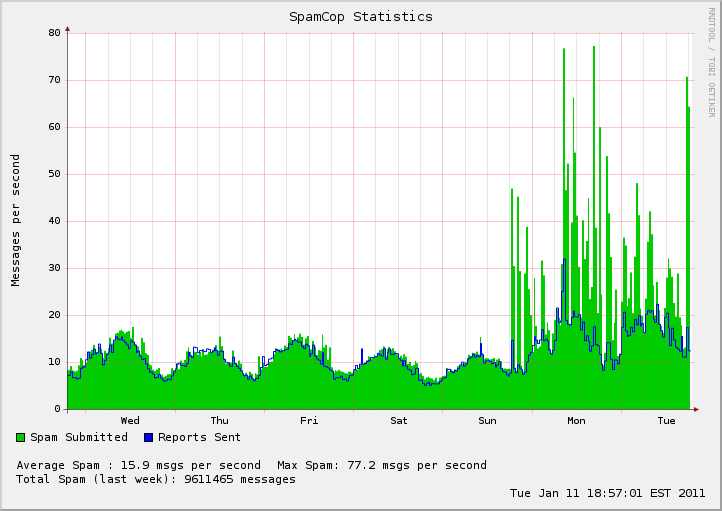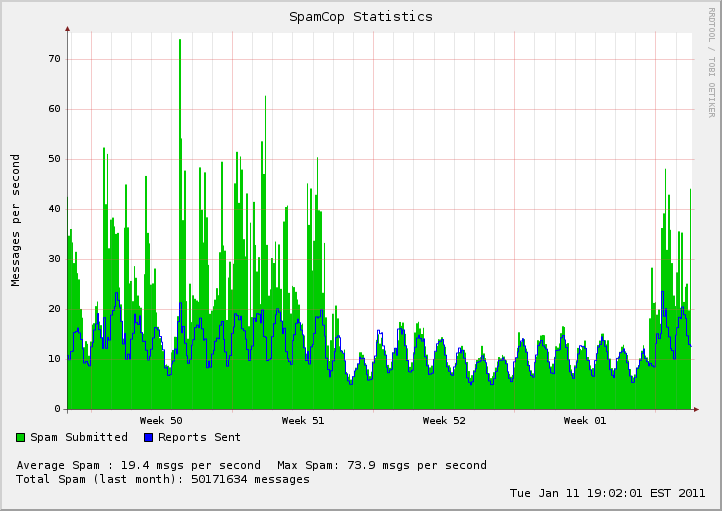Spam Cannons on Holiday
|
The data never lies and always tells a story. Brian Krebs wrote on his blog last week about the decline in spam and his speculation of what has become of the dormant bot nets that get used for delivering spam to the world. There was a clear reprieve in spam deliver over the 2010 year end holiday season for various reasons. SpamCop.net shows a decisive break in spam delivery that resumed action late Sunday. Well, we wanted to share with you some corresponding DShield data. The graph below shows unwanted connections, which should be a good sample representation of infected systems. There is a slight dip which can be attributed to the holiday season or a "weekend drop" type of decline. It does not indicate spam cannons have been replaced by more lucrative malicious channels, nor have the bot nets taken a break either.
|
|
ISC Handler on Duty
January 2011 Microsoft Black Tuesday Summary
Happy New Year Everyone! Here is the 2011 Black Tuesday kick off with only two patches. Enjoy!
Overview of the January 2011 Microsoft Patches and their status.
| # | Affected | Contra Indications | Known Exploits | Microsoft rating | ISC rating(*) | |
|---|---|---|---|---|---|---|
| clients | servers | |||||
| MS11-001 | Vulnerability in Windows Backup Manager Could Allow Remote Code Execution (Replaces None) | |||||
| Windows Backup Manager, Windows Vista SP1/SP2, Windows Vista x64 Edition SP1/SP2 CVE-2010-3145 |
KB 2478935 | Exploit available. | Severity:Important Exploitability: 1 |
Important | Important | |
| MS11-002 | Vulnerabilities in Microsoft Data Access Components Could Allow Remote Code Execution (Replaces None) | |||||
| Microsoft Data Access Components 2.8 SP1/SP2, Microsoft Data Access Components 6.0 CVE-2011-0026 CVE-2011-0027 |
KB 2451910 | No known exploits. | Severity:Critical Exploitability: 1,1 |
Critical | Critical | |
We appreciate updates
US based customers can call Microsoft for free patch related support on 1-866-PCSAFETY
- We use 4 levels:
- PATCH NOW: Typically used where we see immediate danger of exploitation. Typical environments will want to deploy these patches ASAP. Workarounds are typically not accepted by users or are not possible. This rating is often used when typical deployments make it vulnerable and exploits are being used or easy to obtain or make.
- Critical: Anything that needs little to become "interesting" for the dark side. Best approach is to test and deploy ASAP. Workarounds can give more time to test.
- Important: Things where more testing and other measures can help.
- Less Urgent: Typically we expect the impact if left unpatched to be not that big a deal in the short term. Do not forget them however.
- The difference between the client and server rating is based on how you use the affected machine. We take into account the typical client and server deployment in the usage of the machine and the common measures people typically have in place already. Measures we presume are simple best practices for servers such as not using outlook, MSIE, word etc. to do traditional office or leisure work.
- The rating is not a risk analysis as such. It is a rating of importance of the vulnerability and the perceived or even predicted threat for affected systems. The rating does not account for the number of affected systems there are. It is for an affected system in a typical worst-case role.
- Only the organization itself is in a position to do a full risk analysis involving the presence (or lack of) affected systems, the actually implemented measures, the impact on their operation and the value of the assets involved.
- All patches released by a vendor are important enough to have a close look if you use the affected systems. There is little incentive for vendors to publicize patches that do not have some form of risk to them
UPDATE: MS11-002 - Known Exploits changed to "No known exploits". Citation of available exploit was published in error, correction provided by reader Ben L. Thanks Ben!
Kevin Shortt
--
ISC Handler on Duty





Comments